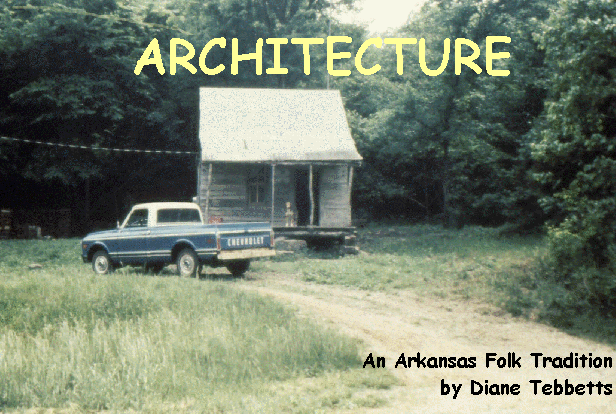
Research funded in part by a grant from the National Endowment for the Arts. Technical assistance provided by Arkansas College Educational Media Center
Originally a slide presentation by Diane Tebbetts, written c. 1980. Click on the small pictures for a larger view, and use the browser 'Back' button to return to the text.
![]() The study of folk architecture is still in its infancy in America. It is a broad
field, with many directions wide open for research. The term “folk architecture”
includes both processes and products, how to build and what to build.
Construction techniques,
The study of folk architecture is still in its infancy in America. It is a broad
field, with many directions wide open for research. The term “folk architecture”
includes both processes and products, how to build and what to build.
Construction techniques,
![]() building forms, and building uses all must
be studied to give us an understanding of how most of our ancestors lived.
Architecture can tell us about their cultural conservatism, their ingenuity,
even their psychology.
building forms, and building uses all must
be studied to give us an understanding of how most of our ancestors lived.
Architecture can tell us about their cultural conservatism, their ingenuity,
even their psychology.
In modern times
_small.jpg) most builders have followed blueprints—some mass-produced and sold through
most builders have followed blueprints—some mass-produced and sold through
![]() popular magazines, for instance, while other blueprints are specially designed
popular magazines, for instance, while other blueprints are specially designed
![]() to suit a particular site or the
individual client’s taste. But throughout most of history,
to suit a particular site or the
individual client’s taste. But throughout most of history,
![]() most
people have lived and worked in structures built by themselves by or by
carpenters trained in a traditional apprenticeship program. These people were
not formally trained architects or structural engineers.
most
people have lived and worked in structures built by themselves by or by
carpenters trained in a traditional apprenticeship program. These people were
not formally trained architects or structural engineers.
![]() Their
knowledge of how to build something, what it should look like, and how it is
used came from slowly-evolving traditions, most traceable directly back to
medieval Europe and Britain. Such is certainly the case in North Central
Arkansas.
Their
knowledge of how to build something, what it should look like, and how it is
used came from slowly-evolving traditions, most traceable directly back to
medieval Europe and Britain. Such is certainly the case in North Central
Arkansas.
Two of these traditions
operate in
![]() folk architecture. These include, first, building
techniques, and then
folk architecture. These include, first, building
techniques, and then
![]() floor plan. Any building technique can be used
to produce any floor plan, and in the past the most common techniques used in
North Central Arkansas were braced frame, log, balloon frame, and box or “single
wall.”
floor plan. Any building technique can be used
to produce any floor plan, and in the past the most common techniques used in
North Central Arkansas were braced frame, log, balloon frame, and box or “single
wall.”
![]() Although stone
is abundant in the area, it was seldom used
Although stone
is abundant in the area, it was seldom used
_small.jpg) for building houses before the
twentieth century. Stone store buildings
for building houses before the
twentieth century. Stone store buildings
![]() from the nineteenth century
still stand in many older Arkansas towns, but they are generally not folk
structures. Brick was also little used in Arkansas folk architecture, although
some traditional house types were built in brick in the growing towns of the
1840s. In the bulk of folk buildings, however, the use of stone and
brick is confined to
from the nineteenth century
still stand in many older Arkansas towns, but they are generally not folk
structures. Brick was also little used in Arkansas folk architecture, although
some traditional house types were built in brick in the growing towns of the
1840s. In the bulk of folk buildings, however, the use of stone and
brick is confined to
![]() foundations—usually just unmortared stacks of
roughly-shaped rocks—and
foundations—usually just unmortared stacks of
roughly-shaped rocks—and
![]() fireplaces,
fireplaces,
![]() which display a
variety of styles and shapes.
which display a
variety of styles and shapes.
The first permanent
dwellings built by English settlers in North America were ![]() braced
frame houses, a building method known in Europe and Great Britain since medieval
times. It remained a major construction technique until shortly before the Civil
War,
braced
frame houses, a building method known in Europe and Great Britain since medieval
times. It remained a major construction technique until shortly before the Civil
War,
![]() when technological advances in the lumber and nail industries
led to the invention of lightweight balloon framing, which is still the major
American house-building technique.
when technological advances in the lumber and nail industries
led to the invention of lightweight balloon framing, which is still the major
American house-building technique.